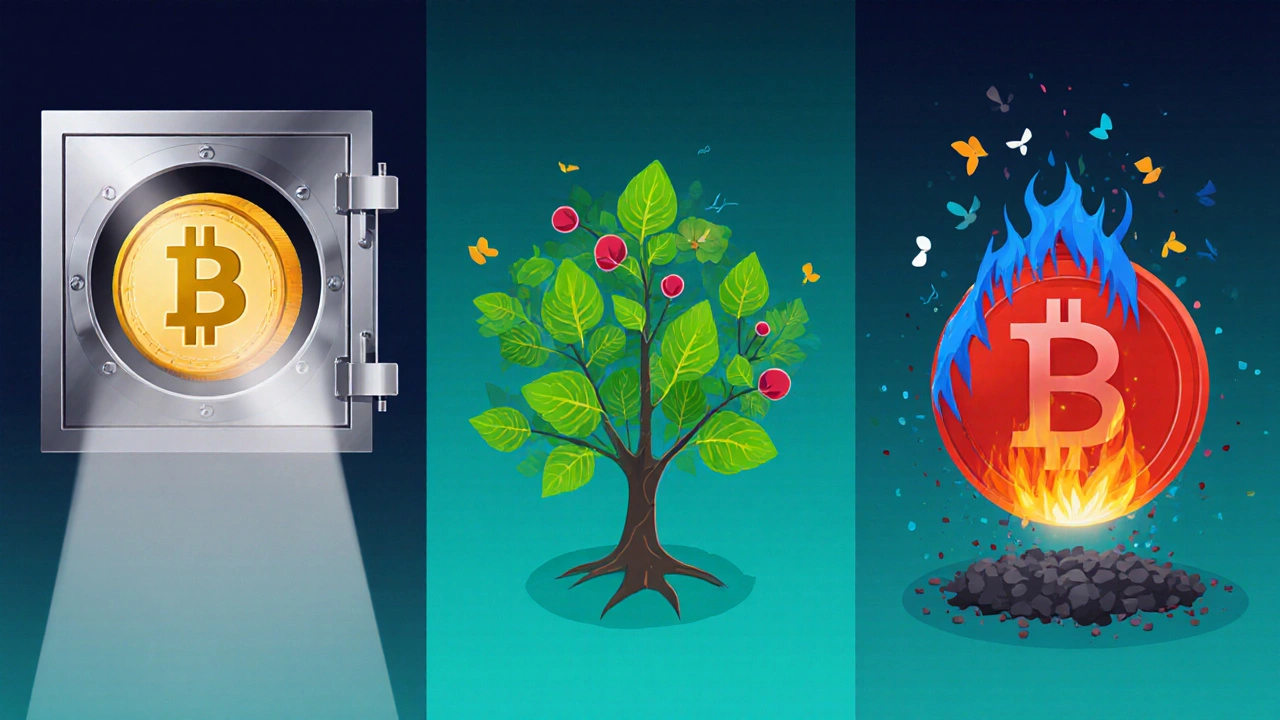Understanding how tokenomics shapes crypto prices can turn speculation into strategy. When you look past the hype and focus on the economics baked into a coin, you start seeing why Bitcoin spikes, why some altcoins crumble, and how new projects can sustain growth.
Key Takeaways
- Tokenomics defines the supply, distribution, and utility of a token, directly influencing price dynamics.
- Fixed, inflationary, and deflationary supply models each create distinct price pressures.
- Utility - staking, governance, and transaction fees - drives ongoing demand beyond pure speculation.
- Transparent token distribution and community incentives reduce price volatility.
- Monitoring on‑chain metrics helps you anticipate price moves before they happen.
What Tokenomics Actually Is
Tokenomics is the economic framework that governs a crypto token, covering its total supply, issuance schedule, utility, and incentive mechanisms. In plain terms, it tells you how many coins exist, how they are created or burned, and why anyone would want to hold or use them.
Core Elements That Move the Price Needle
Every token shares a handful of economic levers. When you understand each lever, you can read the market like a story.
- Supply Mechanics - How many tokens exist now, and how fast will new ones appear?
- Distribution Model - Who holds the coins? Are founders, investors, or the community dominant?
- Utility - What can you do with the token? Pay fees, vote, or stake for rewards?
- Incentive Layers - Are users rewarded for holding, providing liquidity, or securing the network?
- Governance - Does token ownership translate into decision‑making power?
Supply Mechanics: Fixed vs. Inflationary vs. Deflationary
The supply curve is the backbone of price formation. A fixed supply, like Bitcoin’s 21million cap, creates scarcity that can lift price as demand rises. Inflationary tokens, such as many proof‑of‑stake (PoS) coins, mint new units each block, which can dilute value unless new demand outpaces the expansion. Deflationary designs actively destroy tokens (e.g., burn mechanisms on BinanceSmart Chain projects), tightening supply over time.
| Model | Typical Use‑Case | Price Effect | Risk |
|---|---|---|---|
| Fixed (e.g., Bitcoin) | Store of value, digital gold | Scarcity drives upward pressure when demand spikes | Requires sustained demand; sudden sell‑offs can cause sharp drops |
| Inflationary (e.g., Ethereum pre‑EIP‑1559) | Platform utility, smart‑contract execution | New supply can soften price unless network usage grows | Potential dilution if adoption stalls |
| Deflationary (e.g., SafeMoon) | Community‑driven tokens with burn fees | Burns reduce circulating supply, creating upward bias | Burns may be unsustainable; hype‑driven volatility |

Token Distribution: Who Holds the Coins?
Cryptocurrency distribution determines market stability. If 70% of a token sits in a handful of wallets, a single whale can trigger massive price swings. Transparent projects publish token‑allocation charts, showing percentages for founders, early investors, community airdrops, and reserve funds.
Look for vesting schedules that release founder and investor tokens over years. A gradual release linearly reduces sell pressure, whereas immediate unlocks can trigger a crash when the market absorbs the influx.
Utility Drives Ongoing Demand
Utility is the "use case" engine. Tokens that pay transaction fees (e.g., Gas on Ethereum), grant access to services (e.g., Filecoin storage), or enable staking rewards keep holders engaged beyond price speculation.
Take Staking Rewards as an example: Users lock their tokens to secure the network and earn additional tokens. This creates a built‑in demand curve-people hold rather than sell because they earn more by staying in.
Governance tokens like Governance Token (e.g., Uniswap’s UNI) give voting rights. When holders can shape protocol upgrades, they’re incentivized to keep their stake, reducing circulating supply and supporting price.
Incentive Structures: From Liquidity Mining to Burn Fees
Liquidity mining programs reward users for providing assets to decentralized exchanges. The reward token’s price often spikes during the program launch, then settles as rewards taper.
Burn fees, a core part of deflationary tokenomics, take a small percentage of every transaction and destroy it. This mechanic mirrors Bitcoin’s transaction‑fee model but adds a direct supply‑reduction component.
On‑Chain Metrics to Watch
Numbers don’t lie; they just need the right lens. Here are three on‑chain metrics that translate tokenomics into price signals:
- Circulating Supply vs. Total Supply - A widening gap signals future dilution.
- Staked Ratio - The percentage of tokens locked in staking contracts; a rising ratio often predicts price stability.
- Active Addresses - More unique wallets interacting with the protocol indicates genuine demand.
Combine these with off‑chain data (news, regulatory events) for a full picture.

Case Study: How Tokenomics Shifted Bitcoin’s Price in 2024
In early 2024, Bitcoin’s supply schedule hit the “halving” milestone, cutting block rewards from 6.25 to 3.125 BTC. This predictable supply shock reduced the inflation rate from ~1.8% to ~0.9% annually. Simultaneously, institutional demand surged due to a new ETF listing. The double‑hit-lower supply growth and higher demand-propelled Bitcoin from $28k to $45k within six months.
The lesson? When tokenomics events (halving, supply reductions) align with external demand, price moves can be dramatic.
Practical Checklist for Evaluating Tokenomics
- Identify the total and circulating supply. Is there a cap?
- Map the issuance schedule: fixed, inflationary, or deflationary?
- Review token distribution charts. Are there large, unvested holdings?
- Assess utility: fee payment, staking, governance, or access?
- Check incentive layers: liquidity mining, burn fees, reward rates.
- Monitor on‑chain metrics weekly for shifts in staked ratio or active addresses.
- Cross‑reference upcoming token‑economics events (halvings, burns, vesting cliffs).
Common Pitfalls and How to Avoid Them
Ignoring Vesting Schedules - A token may look scarce now but could flood the market in months. Always look for lock‑up periods.
Chasing Hype without Utility - Tokens with flashy marketing but no real use‑case often collapse once the buzz fades.
Over‑reliance on Inflationary Rewards - High staking yields can be unsustainable; when reward rates drop, holders may dump.
Stay disciplined: match tokenomics signals with your risk tolerance and investment horizon.
Frequently Asked Questions
What is tokenomics?
Tokenomics is the set of economic rules that govern a cryptocurrency’s supply, distribution, utility, and incentives. It explains why a token exists, how new tokens are created or destroyed, and what makes users want to hold or use it.
Why does a fixed supply often mean higher prices?
A fixed supply creates scarcity. When demand rises and the total number of tokens cannot increase, each token becomes more valuable, similar to a limited‑edition collectible.
How does staking influence price?
Staking locks tokens in a contract, reducing the amount available for trading. Stakers also earn rewards, creating a financial incentive to keep their tokens instead of selling, which can support or lift the price.
What are burn fees and why do they matter?
Burn fees take a small slice of each transaction and permanently remove it from circulation. By continuously shrinking supply, burn fees add upward pressure on price if demand stays steady.
Can I predict price movements from tokenomics alone?
Tokenomics provides a solid foundation, but external factors-regulation, macro‑economics, market sentiment-also play big roles. Use tokenomics as a base, then layer on news and on‑chain data for a fuller forecast.

